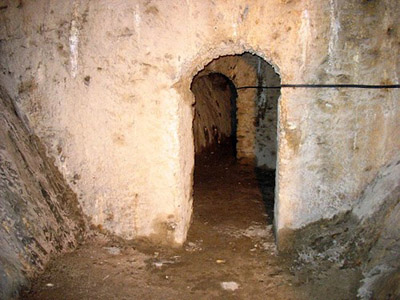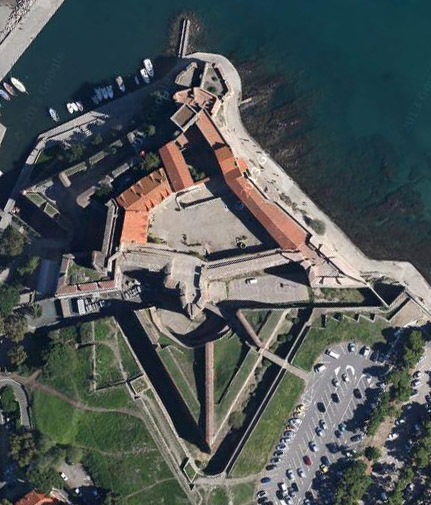 |
Fort Saint Elmo
Collioure, Pyrénées-Orientales, France
|
|
 |
Constructed: 1538 - 1552
Used by: Spain, France
Also known as: Fort-du-Rocher
Conflicts in which it participated:
Italian War of 1551-59
Franco-Spanish War (1635-59)War of Roussilon (1793-95)
French Revolutionary Wars
|
Saint Elmo, or Saint Erasmus of Formia (died 303AD), is the patron saint of sailors and abdominal pain. One assumes it is due to the sailor connection that Elmo has so many forts of named after him, although trying to differentiate betwixt all the Forts Saint Elmo is certainly giving me abdominal pain.The most famous is of course Fort Saint Elmo on the island of Malta, but there is also an equally fascinating Castel Sant'Elmo in Naples, Italy.
|
 |
|
|
Southern France was an untidy place in the 8th and 9th centuries. It was occupied by the Moors, and Normans and Arabs were all doing their best to kill and/or capture and/or violently convert everyone in sight. The Moors devised a system of lookout towers along the coast: Burning dry wood at night in these towers would shine a bright light that would alert their garrison at Perpignan of untoward doings, while lighting green wood during the day would send up a billowing plume of alertive smoke. The Torre de Guardia was built at Collioure for this purpose. |
|
 |
This warning system worked well, though not well enough to prevent the Moors from being Reconquisted out of the region by the 14th century. Peter IV of Aragon (1319-1387) gained control of this coastal area in 1344, and ordered that the Torre be made into something approaching an actual fort.
France finally hacked their way into control of Roussillon (a little wedge of land in what is today southern France, along the border with Spain, where Collioure lies) from 1462 to 1507. It was they who named the fort after Saint Elmo, and further developed its defensive capability. |
|
Twas the Spanish, however, who were primarily responsible for the starry shape of Fort Saint Elmo that appears before us today. The forces of good old Holy Roman Emperor Charles V (1500-1558) rolled back into Roussilon in 1552 thanks to the Italian War of 1551-59, in which French King Henry II (1519-1559) declared war on the Spanish in the interest of capturing Italy and ensuring French domination of Europe. This war not only did not dislodge the Spanish Habsburgs from Italy, but also lost some territory for France.
|
Lovely pointy star or no, Fort Saint Elmo was captured by the French on April 13, 1642, during the Franco-Spanish War (1635-59), an offshoot of the greater Thirty Years' War (1618-1648): France regained Roussillon and some territories along its border with the Spanish Netherlands.
The timing of this French reattainment of Collioure was fortuitous indeed for Fort Saint Elmo, because along came Vauban (1633-1707), tirelessly improving every starfort in the kingdom! The Father of the Starfort did his improvement thing at the fort of our current interest in 1659. Around 1780, the fort was painted white to serve as a navigation aid for those sailing for Collioure or Port-Vendres.
|
 |
 Looks old, doesn't it. How does mid-15th century grab you? Looks old, doesn't it. How does mid-15th century grab you? |
|
In 1793, France bloodily announced its intention to no longer have a king, by beheading theirs. This caused a good deal of consternation amongst its monarchial neighbors, who joined to beat France back into thinking a monarchy is a good idea. This was a lengthy process indeed. Roussillon saw plenty of vicious fighting, being on the border with Spain. The Roussillon War of 1793-1795 saw French Royalish forces, French Republicans, and then Spanish troops all taking turns at capturing and holding Fort Saint Elmo.
|
|
 |
Six months after the Spanish gleefully planted their flag back atop the fort in 1794, however, it was reclaimed by France, "under the weight of 11,000 balls." Insert adolescent joke here.
Revolutionary France took great joy in sucking the joy out of everything that had existed before the wisdom of Republicanism had shone its light on all before it, a process that generally took the form of renaming things and beheading lots of people. As such Fort Saint Elmo was renamed Fort-du-Rocher. Briefly.
Once every Frenchman had finally been killed in 1815, Collioure and its forts were relegated to the status of military storage facility. |
|
Fort Saint Elmo was finally demilitarized in 1903, and abandoned. The fort was sold to a number of private parties starting in 1913, but nobody could muster the impetus to restore the crumbling beast until it was declared an Historic Monument in 1927. Restoration continued until 1936, which made it a nice place for the German Navy to occupy during the Second World War (1939-1945).
The Nazis blew parts of the complex up upon their departure, to deny its use by the Allies. Another rebuilding effort took place in the 1950's, but it wasn't until a major restoration at the beginning of the 21st century that Fort Saint Elmo could finally be opened to the public with diminished fear of crushing folks to death with crumbling masonry. The fort was opened to the public in 2008.
Collioure was obviously extremely important to somebody, because in addition to this most excellent example of starfortage in Fort Saint Elmo, the town is graced with two additional starfortish entities: Château Royal de Collioure, and Fort Miradoux.
|
Château Royal
Romans conquered Rossillon in 120AD. The first fortification mentioned at Collioure, the Castellum Caucolibérion, was besieged by the Visigoths in 673AD: This was on the spot where the Château now resides.
Is the Château a starfort? Sure it is! It certainly has starfortish aspects, thanks, once again, to the ministrations of Vauban around 1660. The Château suffered much the same history as Fort Saint Elmo, with the Knights Templar, Kings of Majorca, Spanish and French all playing tug o' war with its possession over the centuries.
The Knights Templar built the first real castle on this spot in the early 13th century. Castle #2 was built there by the Kings of Majorca in the 14th century, the Spanish Habsburgs modernized things at the beginning of the 16th century, and the French, under the direction of Vauban, created its final evolution.
|
 |
 |
|
| The heavily fortified town of Collioure as it appeared in the 18th century. |
 |
The Château was named an Historic Monument in 1922. In 1939 it was made a prison, serving as a disciplinary camp for refugees from the Spanish Civil War (1936-1939)...always important to discipline refugees. Today, the Château is a Renaissance museum, crammed full of armor, pointy weapons and firearms of the era.
Collioure, on the Mediterranean Sea and at the border with Spain, was an extremely important bastion of the French Empire (or whatever other empire possessed it at any given moment). It's a very little place, but has loomed large in the annals of European warfare, as the impressive array of fortification attests.
|
|
|
|
|
|
|
|
|
 |




